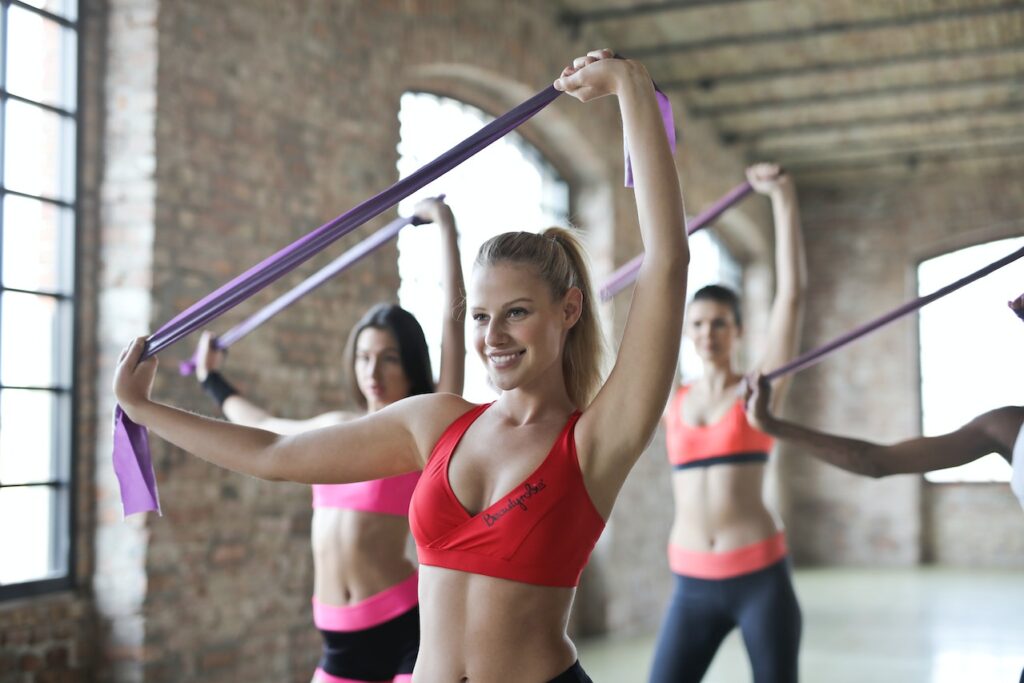The Versatility of Resistance Bands
Resistance bands are incredibly versatile and can be used to target and tone a wide range of muscle groups. Whether you’re focusing on your upper body, lower body, or core, there’s a resistance band exercise to meet your needs.
- Upper body: Resistance bands can be used to perform exercises like bicep curls, tricep extensions, shoulder presses, and chest presses, among others.
- Lower body: You can perform squats, lunges, glute bridges, and more with resistance bands to strengthen your lower body.
- Core: Resistance bands can aid in core workouts with exercises such as planks, crunches, and rotations.
This adaptability makes resistance bands an essential fitness accessory for your home gym, allowing you to create comprehensive and balanced workout routines.
Read our article to choose the right home gym equipment for your needs.

Benefits of Resistance Bands in Strength Training
When it comes to strength training, resistance bands offer a unique advantage. Unlike traditional weights, resistance bands don’t rely on gravity to provide resistance. This allows for a larger range of motion and the ability to change your positioning in multiple ways.
- Adjustable Resistance: Resistance bands come in different resistance levels, from light to heavy. As your strength improves, you can move up to bands with higher resistance to continue challenging your muscles.
- Continuous Tension: Resistance bands provide constant tension throughout the exercise, keeping your muscles engaged at all stages of the movement. This can lead to more effective muscle development.
Ready to create your dream home gym? Get started with our comprehensive guide.
Using Resistance Bands for Cardio Workouts
In addition to their benefits for strength training, resistance bands can also be effectively incorporated into cardio workouts. By adding an element of resistance to cardio exercises, you can enhance their intensity and increase your heart rate more efficiently. This promotes cardiovascular health and aids in weight loss.
- Jumping Jacks with Resistance Bands: Perform traditional jumping jacks while holding a resistance band with both hands stretched above your head. The added resistance engages your upper body during the exercise.
- Squat to Press with Resistance Bands: Combine a squat and overhead press with a resistance band. This exercise increases your heart rate while also working your lower body and shoulders.
Incorporating resistance bands into your cardio routines can therefore lead to more dynamic and effective workouts, maximizing your fitness results in the process.
Limited space? Check out our clever space-saving ideas for your home gym.

Compact and Affordable: Resistance Bands for Small Spaces
When creating a home gym in a small space, equipment size matters. Thankfully, resistance bands are compact and easy to store, making them a perfect fit for even the smallest of homes. They can be neatly packed away in a drawer or hung on the wall when not in use, keeping your workout space clutter-free.
Furthermore, resistance bands are an affordable addition to your home gym setup. Unlike many pricey pieces of fitness equipment, a quality set of resistance bands can be purchased at a fraction of the cost, making them a budget-friendly solution for your strength training and cardio workouts.
No gym equipment? No problem! Get started with bodyweight exercises.
Resistance Band Safety Guidelines and Exercise Technique
As with all exercise equipment, it’s crucial to use resistance bands safely. Keep these guidelines in mind:
- Inspect Your Bands: Regularly check your bands for signs of wear and tear to avoid sudden snapping or breaking during a workout.
- Correct Form: Always use correct form and technique when performing exercises. Incorrect form can lead to injuries and minimize the effectiveness of your workouts.
- Proper Handling: Ensure you’re handling the bands correctly to avoid snapback. Never let a band go while it’s under tension.
Resistance Bands: For Beginners to Advanced
Resistance bands are beneficial for individuals at all fitness levels. Here’s how each group can use them:
- Beginners: Light resistance bands are perfect for beginners. They offer a manageable level of tension, allowing new exercisers to gradually build strength.
- Intermediates: As strength and endurance improve, intermediate exercisers can transition to bands with higher resistance.
- Advanced: For advanced exercisers, heavy-duty bands provide significant resistance, supporting continued muscle development and strength gains.
